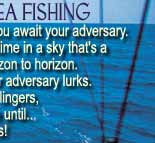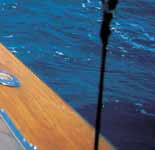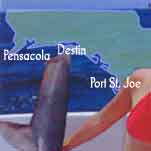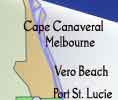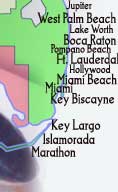| Know before you go Before you put down a deposit and start channeling Hemingway, there are some questions you might want to ask: How much does it cost? Charter prices are quoted per boat, not per person. They start in the $400-$500 range for half days and might be $900 for a full day in Miami. Charters generally take a maximum of six people. Party boats can carry as many as 50. You buy an individual ticket, which is cheaper than splitting the charter price -- but you're also sharing the boat with folks who just want to admire the water. What amenities does the boat have? Most boats have bathrooms -- called the "head" -- but not all are air conditioned. This could be important. Locals might think it's a pleasant day, but by your thermostat it's 10 degrees hotter than a blast furnace. Can you keep your fish? Some boats -- including Krupka's and Creech's -- will clean and filet your catch for you and hand it over with a smile. Other boats keep half or more of what you reel in. Billfish should always be released. If you think your friends won't believe you caught something without proof, measure and photograph the fish, then take the info to a taxidermist -- your captain can recommend one -- who can replicate it. Voila -- a souvenir without killing the fish. Now that you've signed up for a charter, you'll want to bring: Sunscreen, of course. And sunglasses. A hat wouldn-t be a bad idea either. Seasickness remedy. Be sure to take it before you get on. Many boats stock Dramamine, but by the time you feel ill, it?s too late to take anything. Soft shoes. You don't want to fall off. The captain doesn't want you to damage his boat either. A camera. You might see dolphins, sea turtles or even a whale. Food and drink. Lunch generally isn't included in the price, though sometimes it can be arranged with sufficient notice. Party boats, however, often include beverages and edibles. And finally: Tip the first mate 15 percent to 20 percent. He's the one who teaches you how to use the tackle and the boat's safety equipment (and the head -- very important!). If there's fish cleaning to be done, he does it. On many boats, tips ARE his salary. |
What's on my line,
or a guide to the common catch There's lots of fish in the sea... and in the Gulf. If you're lucky enough to snag one off the Florida coast, it might be one of these:  Amberjack Has a dark stripe from the nose to in front of the dorsal fin. Generally found near rocky reefs, debris and wrecks offshore, though it may be found near shore in South Florida. The largest of the jack family, it commonly weighs in at about 40 pounds. Cobia Brown or gray above, with a dark stripe from gills to tail, and whitish underneath, Cobia can look a lot like a shark in the water. Generally run 20-50 pounds, though they may grow to 100 pounds or more. Lives near shore or inshore. Usually eaten smoked or fresh.  Dolphin This is mahi-mahi, not Flipper. These are brightly colored fish - greenish blue on top, yellow on the sides, and may flash purple, chartreuse or other colors. Found in warm offshore waters, they commonly run to about 30 pounds. Works well in a variety of recipes.  Grouper A member of the sea bass family, groupers are some of the most popular fish caught off the coast of the Sunshine State. They generally live on rocky shore bottoms or near reefs. Color, depending on the species, can range from olive or gray with black blotches to brownish red. In size they range from about 15 pounds for red groupers to more than 100 pounds for some of the larger black groupers. A popular food fish, grouper is yummy when fried, broiled or blackened.  Marlin With bright colors, a pointed dorsal fin and an upper jaw elongated into a spear, this is one cool-looking fish. Blue marlins are cobalt on top, shading to silvery white underneath; white marlins may be dark blue to chocolate brown. Blues are the largest of the Atlantic variety commonly reaching 11 feet long and weighing more than 2,000 pounds. All of the trophy-size specimens are females.  Sailfish Gets its name from its spectacular dorsal fin. They're generally dark blue on top, brownish-blue on the sides and silvery white underneath. Like the marlins, the upper jaw is spear-shaped. Average size is 7 feet. Generally found in south Florida near the Gulf Stream and off the Panhandle near the 100-fathom line.  Snapper Hard fighters that play tug-of-war with the angler. Most have prominent canine teeth and will take a variety of bait. They got their name from their habit of snapping at the angler's hands. Colors vary but are generally bright and tend toward red and yellow. Some are small -- 5 pounds or so -- but other varieties commonly grow to 40 pounds or more. Excellent for dinner.  Swordfish Another flashy fish: color can range from black to grayish-blue to brown, purple or bronze. Has a long, flat sword-like upper jaw. Lives in deep blue water and once averaged more than 200 pounds, though overfishing has affected the size of commercially caught fish. All large swordfish are females.  Tarpon Its stubborn refusal to give up, combined with an ability to leap 10 feet out of the water, makes tarpon a favorite game fish. Generally green or steel blue on top and silvery on the sides and underneath. Found both inshore and offshore, usually on the Gulf side. They generally range 40-50 pounds, though 100 pounds is the norm at Boca Grande Pass and 200 pounds is not unheard of.
Fish illustrations courtesy of Indian River County
|
|
|||||||||||||||
|---|---|---|---|---|---|---|---|---|---|---|---|---|---|---|---|
FLORIDA
 FISHING FISHING
For the adventurous angler, booking a charter is the easiest and most popular way to get to the denizens of the deep. All the details -- licenses, bait, tackle, equipment -- are taken care of. "A charter or guide provides you with an experienced crew and a convenient, carefree way for just about anyone to enjoy a day of fishing or just a day out on the water," said Linda Krupka, captain of Action Charters in Miami. "Your group boards the boat and everything is taken care of for them. We do all the worrying about tackle, equipment, bait, etc. and we do all the cleaning up afterwards. What more could anyone want?"
Trips are usually either half-day or full-day outings. Half-day trips last four or five hours and might go 3 to 10 miles from shore. Most leave the dock early -- like at 7 a.m. Some do a second run in the afternoon. All-day trips are just what they sound like and may go 20 or 25 miles from shore. They?re also more likely to go after the big fish, such as marlin, or to troll for tuna. Mark has a rep for going after game and is much in demand with serious anglers and celebrities. Robert DeNiro's been on his boat, as has rapper/actor Will Smith and an assortment of sports stars, rock stars and other big names.
At least he/she should, and that's something you'll want to research before handing over your money, said Ralph Creech, captain of Atlantic Blue Water Charters in Port Canaveral. Check out the captain's website, if there is one, he suggests, and/or "go to the dock a couple days prior and see what theyre bringing in." A boat's daily itinerary usually depends on which fish are running where and the location of the captain's "secret spots." On a recent outing, Creech's clients came back with four 20- to 25-pound gray groupers, a red grouper and four red snappers. On another trip, a company had rented two of his boats. He piloted one, another captain took the other. His boat came back with a haul, the other came back empty of fish and full of grumpy clients. When you catch a food fish -- grouper and snapper are popular -- Krupka and Creech have it cleaned and filleted for you when you get back to shore. You can take it home or to certain restaurants that will cook it for you. Some of Krupka's clients, however, have loftier goals. They see themselves as latter-day Hemingways, wrestling and besting a sailfish. "It's the epitome of sport fishing," Krupka agreed, though most people are happy when they catch anything. Unlike food fish, sailfish and their billfish brethren are always released. Sometimes they're tagged before being put back in the water. Photos make great souvenirs. Or you can take the photo and some measurements to a local taxidermist and have a replica made to impress the folks back home. It's a win-win situation: you get a trophy, the fish gets to live another day. Trophy fishing brings up another issue: the stereotype of deep-sea fishermen is that they're all macho, hard-drinking, Hemingway-wannabes. Truth is slightly different. Yes, males predominate and most enjoy a brewski or three. But women fish, too. So do kids and retirees. Krupka finds that youngsters especially like to catch bait fish, something she does at the beginning of a charter on her way out to the big water. As for females, Krupka finds that they usually come on the boat simply to accompany their menfolk and plan to spend the trip catching rays, not some slimy old fish. Then curiosity -- or maybe coaxing -- gets the better of them and they find themselves reeling in a whopper. From that point on, they're... uh, hooked. On Creech's boat, the boys best watch out. "Women normally outfish the men," he said. Why? "They don't try to muscle the fish," he explained. "You got to go easy on some fish. It's more technique than it is muscle." "I'd rather fish with females," Mark the Shark agrees. "They listen. They make better anglers because they listen to what I tell 'em." No one can guarantee fish, Mark said. Sometimes conditions just aren't right. And when you do 700 trips a year, you're just not going to get the goods every time. "That's why they call it 'fishing', not 'catching'," he quipped. Still, deep-sea fishing may not be for the faint of heart or sensitive of stomach. These are big fish -- snapper and grouper routinely run 20 to 50 pounds or more and billfish can be 7 feet long and weigh several hundred pounds -- and they have to be gaffed to be hauled onto the boat. The process can be a little messy, especially in the eyes of those who have trouble killing anything bigger than a mosquito. Krupka makes a point of keeping her operation clean. Fish go "in the box" on ice immediately, she said, and the cockpit, where the fishing takes place, is kept hosed off. |





